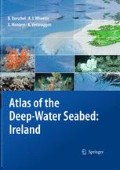Abstract
Seamounts are distinct, elevated, geological seabed features, often of volcanic origin. They are at least 1,000 m tall but do not reach the sea surface (Fig. 8.1). The majority of seamounts are conically shaped when young but due to erosion become more irregularly shaped over time with circular to elliptic elongated bases and often flat summit areas. The slopes of seamounts can be quite steep, sometimes up to 60° (Fig. 8.2).
Access this chapter
Tax calculation will be finalised at checkout
Purchases are for personal use only
Bibliography
Clark, M. R., Tittensor, D., Rogers, A. D., Brewin, P., Schlacher, T., Rowden, A., et al. (2006). Seamounts, deep-sea corals and fisheries: Vulnerability of deep-sea corals to fishing on seamounts beyond areas of national jurisdiction. Cambridge, UK: UNEP-WCMC.
Genin, A., Dayton, P. K., Lonsdale, P. F., & Spiess, F. N. (1986). Corals on seamount peaks provide evidence of current acceleration over deep-sea topography. Nature, 322, 59–61.
Glover, L. K., & Earle, S. A. (Eds.). (2004). Defying ocean’s end (pp. 45–70). Washington, DC: Island Press.
Gubbay, S. (2003). Seamounts of the North-East Atlantic. WWF Germany: OASIS.
Pitcher, T. J., Morato, T., Hart, P. J. B., Clark, M. R., Haggan, N., & Santos, R. S. (2007). Seamounts: Ecology, fisheries & conservation. Oxford: Blackwell. 552 pp.
Roberts, D. G., Hogg, N. G., Bishop, D. G., & Flewellen, C. G. (1974). Sediment distribution around moated seamounts in the Rockal Trough. Deep Sea Research and Oceanographic Abstracts, 21, 175–184.
Roberts, C. M. (2002). Deep impact: The rising toll of fishing in the deep sea. Trends in Ecology and Evolution, 17(5), 242–245.
Rogers, A. D. (1994). The biology of seamounts. Advances in Marine Biology, 30, 305–350.
Stone, G. S., Madin, L. P., Stocks, K., Hovermale, G., Hoagland, P., Schumacher, M., et al. (2004). Seamount biodiversity, exploitation and conservation. In L. K. Glover & S. A. Earle (Eds.), Defying ocean’s end (pp. 45–70). Washington: Island Press.
Weaver, P. P. E., Billett, D. S. M., Boetius, A., Danovaro, R., Freiwald, A., & Sibuet, M. (2004). Hotspot ecosystem research on Europe’s deep-ocean margins. Oceanography, 17(4), 132–143.
Author information
Authors and Affiliations
Corresponding author
Rights and permissions
Copyright information
© 2010 Springer Science+Business Media B.V.
About this chapter
Cite this chapter
Dorschel, B., Wheeler, A.J., Monteys, X., Verbruggen, K. (2010). Seamounts. In: Atlas of the Deep-Water Seabed. Springer, Dordrecht. https://doi.org/10.1007/978-90-481-9376-1_8
Download citation
DOI: https://doi.org/10.1007/978-90-481-9376-1_8
Published:
Publisher Name: Springer, Dordrecht
Print ISBN: 978-90-481-9375-2
Online ISBN: 978-90-481-9376-9
eBook Packages: Earth and Environmental ScienceEarth and Environmental Science (R0)

